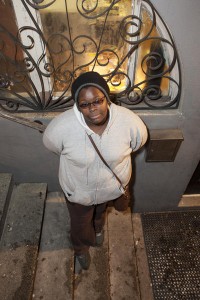10 percent of Chicago’s homeless population is aged 14-21
By Tracy Swartz

Like many 18-year-olds, Precious “Mya” Smith is learning how to set goals for herself:
» Finish high school coursework.
» Look into applying for college. Smith is particularly fond of Roosevelt University because of its intimate feel and its new Wabash Building, a glass tower ensconced in blue, her favorite color.
» Find a home.
This last goal is the one that keeps Smith up at night. Since December, she has been homeless, bouncing between The Crib and Safe Haven shelters in Chicago, and occasionally sleeping on the Red Line overnight.
“It’s like a challenge every day,” Smith said about the shelter lottery process to determine her home for the night. “Because if you get in, that’s fine and you’re safe. But if you don’t get in, then you’re not fine and you’re not safe.”
The Chicago Coalition for the Homeless, a network of social service agencies, estimates there are about 11,000 homeless Chicagoans between 14 and 21 years old, about 10 percent of the homeless population. Service experts say there’s no way of knowing for sure how many Chicagoans don’t have a home, though the city is trying to figure that out—on Jan. 22, it completed a one-day census of people sleeping in shelters and on the streets.
The biennial count, which the U.S. Department of Housing and Urban Development requires, will give the city an idea of how to allocate its resources, which agencies say have recently been stretched thin because of demand.
Last month, service agencies asked the CTA to approve a discounted fare card for homeless youth who don’t regularly attend school but need the card to look for jobs or receive services. The CTA said it would work with the agencies to try to help.
Separately, the city plans to allocate $4.8 million this year for new and expanded homeless services, said Matt Smith, spokesman for the city Department of Family and Support Services. This money will go to more shelter beds and permanent housing solutions.
Smith’s go-to shelter has been The Crib, located in the Lakeview Lutheran Church, ever since she decided to become homeless. Her mother died of breast cancer when she was in seventh grade. For four years, she lived with her sister until some personality clashes led her to leave behind her home in Roseland a few weeks before Christmas. Other family members don’t know Smith is sleeping at homeless shelters, she said.
Smith, formerly a senior at Ralph Ellison High School in Auburn Gresham, dropped out of school. She packed a bag of clothes, soap, deodorant and her favorite Bath and Body Works Paris Amour scent and headed to the North Side, where she spends her days at the Broadway Youth Center in Lakeview before heading over to The Crib to try to win a lottery for one of its 20 beds.
Smith has been pretty lucky in the lottery—only a few times has she gone to the Safe Haven, a 20-bed shelter in North Lawndale, instead. The Red Line is her last, and most dreaded, choice.
“It’s so nerve-racking,” Smith said of the Crib lottery, which involves slips of paper and a bucket.
Tedd Peso, government relations manager for the Night Ministry, which runs The Crib, said agencies increasingly have been unable to help some of those in need.
“I would say our shelters are fuller; there’s more demand for our services, meaning we’re turning more people away,” Peso said. “The people we’re serving have not experienced homelessness for the first time.”
Over the years, there have been a couple of city plans to tackle homelessness in Chicago. In 2003, former Mayor Richard M. Daley advocated for a 10-year plan to curb homelessness, which called for a move away from emergency shelters and toward permanent, affordable housing options.
Currently, the city is working from Mayor Emanuel’s Plan 2.0: A Home for Everyone. The city hopes to increase the capacity of the youth housing system, which includes shelters and transitional housing, from 266 beds to 800 beds by 2019. Other goals include improving crisis intervention and family mediation services and boosting support within Chicago Public Schools.
“This plan was assembled with the input of more than 500 stakeholders from Chicago’s homeless scene,” Matt Smith said. “When they made their recommendations, they rejected what didn’t work, built on what did and weren’t afraid to think out of the box.”
Precious Smith, too, has learned to think outside the box. She has found what works for her is setting small goals every day in the hope they will lead to larger accomplishments. She said she will start taking classes this month to get her GED. She plans to sign up for food stamps and transitional housing.
She’s not sure what she wants for a career but she said she enjoys reading and writing, especially in her journal. One of the points she wants to convey is that even though she is homeless, she is not alone.
“I think being homeless isn’t really homeless. It’s just house-less. I still do everything that people that have homes do. It’s just I don’t have as much and I take it with me everywhere.”
Watch a video interview with Precious on the RedEye website.
